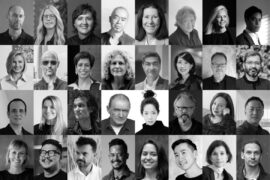Architects and designers can’t control the climate; but we can control how we think, design and build. Climate action means having the courage to change it.

August 19th, 2021
“Change is happening, and you (and whatever your building) are going to be part of it.” Dr. Jeremy Smith, made no bones about stating this matter of fact, while discussing finding and financing sustainability with Iwan Sunito, Emma Telfer, and Stephen Cairns, in a panel during the inaugural INDE.Summit.
Each an expert of sustainable development in their own right, Sunito (Crown Group, Australia), Telfer (Assemble, Australia), Smith (Irving Smith Architects, New Zealand) and Cairns (Future Cities Laboratory, Singapore) comprise a panel of industry experts with knowledge and know-how of what it takes to realise climate action in the built environment, across diverse typologies, scales and geo-contexts.
“As soon as you acknowledge that you are participating in what you think is changing, then you begin to embrace change,” Smith explains Irving Smith Architects’ approach to realising positive climate action in practice.
Taking a leaf out of the addiction recovery book, core to Irving Smith’s approach is accepting what is, as it is, and if you don’t like it, changing whatever is within your control to fix it.
“You have to ask yourself the question, how you’re going to respond to it? Solutions might be spatial, and they might be physical – but there will always be ways that you can approach it.”
In Singapore, Stephen Cairns’ work as director of Future Cities Laboratory, is quite unlike that of Irving Smith Architects, based in Nelson, New Zealand, which is focused sustainable architecture in the residential and public spheres. Despite their practical differences, Smith and Cairns share the view that architects ought to change their thinking, in the interest of making climate action happen.
“As most of us [architects] are, in a way, learning how to initiate climate action on projects as we go, we have to propose new ways of interacting with productive landscapes and agriculture as part of this large urbanisation sustainability project,” says Cairns.
“The rise of autonomous vehicles is perhaps one of the great—I’m hesitant to say, ‘silver bullets’—but it’s certainly one of the really key areas where we can address the 70% carbon emissions – if buildings account for 40%, then a big chunk of the remaining figure has to do with transportation,” he elaborates.
Though, as Cairns says, “it might seem a bit exotic”, architects have an opportunity (or onus), as the creative force of the built environment, to be the ones to help direct engineers and policy makers bring such technology into our lives.
As for who or what is responsible—government or private business?—for driving such systemic changes, the verdict is out. From a property development perspective, Iwan Sunito commends the NSW government for introducing initiatives that lay the law for residential building standards. Such government issued directives have done wonders for keeping the industry in check, and giving the likes of Crown Group a benchmark to go above and beyond.
Financing sustainable development is another grey area as to who/what is ultimately responsible for. Assemble poses an interesting case study for financing its fight for housing affordability through values-aligned business partnerships – specifically, the investment of Australian Super, which gives the country’s largest super fund a 25 percent stake in Assemble’s business. According to Emma Telfer, this fortuitous partnership has eventuated as a result of Assemble’s purpose-driven approach.
“By orientating ourselves around the US Sustainable Development Goals, we’ve identified 7 that are mission critical to us, out of the 17. It’s Assemble’s ambition to not only not doing any harm for future generations, but to actually significantly advance development in the face of climate change and growing inequalities,” says Telfer.
“In terms of the social sustainability and responding to inequality, the housing model which we have built on is the rent-to-buy model—where we’ve developed an alternative pathway in homeownership—that’s really responding to a big societal challenge that we have here in Australia… and for that reason, Australian Super invested into Assemble, and so that they can deliver sustainable returns to members.”
If you missed the live finding and financing sustainability panel discussion, moderated by the University of Tasmania’s Dr. Helen Norrie, not to worry – we’ve got you covered. To hear every insight firsthand, the recorded session is accessible in full and on demand.
INDESIGN is on instagram
Follow @indesignlive
A searchable and comprehensive guide for specifying leading products and their suppliers
Keep up to date with the latest and greatest from our industry BFF's!

Merging two hotel identities in one landmark development, Hotel Indigo and Holiday Inn Little Collins capture the spirit of Melbourne through Buchan’s narrative-driven design – elevated by GROHE’s signature craftsmanship.

In an industry where design intent is often diluted by value management and procurement pressures, Klaro Industrial Design positions manufacturing as a creative ally – allowing commercial interior designers to deliver unique pieces aligned to the project’s original vision.

Sydney’s newest design concept store, HOW WE LIVE, explores the overlap between home and workplace – with a Surry Hills pop-up from Friday 28th November.

At the Munarra Centre for Regional Excellence on Yorta Yorta Country in Victoria, ARM Architecture and Milliken use PrintWorks™ technology to translate First Nations narratives into a layered, community-led floorscape.

With the 2025 INDE.Awards now over, it’s time to take a breath before it all begins again in early December. However, integral to the awards this year and every year is the jury – and what an amazing group came together in 2025.

This year the INDE.Awards jury breaks all records as the largest and most iconic group ever gathered together for the program.
The internet never sleeps! Here's the stuff you might have missed

J.AR OFFICE’s Norté in Mermaid Beach wins Best Restaurant Design 2025 for its moody, modernist take on coastal dining.

Now cooking and entertaining from his minimalist home kitchen designed around Gaggenau’s refined performance, Chef Wu brings professional craft into a calm and well-composed setting.